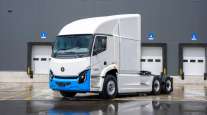Staff Reporter
How Government Incentives Drive Electric Truck Adoption

[Stay on top of transportation news: Get TTNews in your inbox.]
President Joe Biden has made proliferation of electric vehicles a focus of his administration, with the commercial transportation industry playing a key role.
Adoption of EVs was at the forefront of The Inflation Reduction Act of 2022, with specific focus on the commercial vehicle sector. The legislation includes a tax credit for the purchase of electric commercial vehicles that’s equal to 30% of the vehicle’s purchase price, up to $40,000 per unit.
“The Inflation Reduction Act is really going to stimulate a ton of electric vehicle acquisitions in the commercial fleet industry,” Nick Kappas, federal tax credit transactions attorney at Thompson Coburn, said. “It’s a new section of the code and it deals directly with tax incentives for converting or upgrading your commercial vehicles. It doesn’t have to be an entire fleet, but [can be] any commercial vehicle to an EV commercial vehicle. That can be a battery-powered EV or it can be a hydrogen fuel cell-powered electric vehicle.”
Kappas pointed out that the lack of domestic content, supply chain and battery component requirements that are otherwise common in these sorts of initiatives adds another layer of incentives for fleets to convert.

Kappas
“As far as tax code provisions go, it’s pretty straightforward,” Kappas said. “You can get a tax credit, and a lot of these programs are all incentivized by the awarding of tax credits for particular expenditures.”
Kappas expects early adopters already considering EVs to be the first ones claiming the credits, but expects other carriers to eventually follow suit.
“They’re going to be a little more familiar and they’re going to jump into it,” Kappas said of the frontrunners. “I think the goal of the code section is — and I think it’s probably going to play out this way — is that you’ll have other carriers, other commercial operators, see that investing sooner rather than later is going to give you long-term savings.”
The IIJA also outlines plans for construction of a national network of 500,000 electric vehicle chargers, and sets a goal of having at least half of new car sales be electric by 2030.
“All of those sorts of things are happening, to really to push the end users and the OEMs to think about these zero emission technologies and how they can be used to help meet [certain] specific requirements, said Brian Wilson, general manager of electrified components at Accelera by Cummins.
Wilson said that this push by the government is coupled with market incentives, and noted that increasing availability and improved technological development of equipment is helping to bring down the cost curve. For fleets, there is incentive as more shippers adopt Environmental, Social and Governance targets that prioritize cleaner supply chains.
“There are incentives coming from the governments that are helping to incentivize the investment in these technologies,” Wilson said. “Whether it’s the research and development costs, or the capital costs required to build this technology, or even some incentivization to the end users to lower that upfront cost.”

Joel Morrow of Alpha Drivers Testing & Consulting traveled across America asking one simple question: What if a trucker designed a truck? Hear the program above and at RoadSigns.TTNews.com.
One trucking industry group pointed out that limitations exist when it comes to how far the government pushes these policies. The Truckload Carriers Association has argued that technology and charging infrastructure requirements that are propelling the EV passenger car segment aren’t there yet for mass adoption of electric trucks. And it took particular issue with the U.S. government signing an international agreement to reach zero-emission for all new medium- and heavy-duty vehicles by 2040.
“I think these deadlines have been set to push these vehicles on an industry without industry input,” said Dave Heller, the group’s senior vice president of government affairs. “We want to be part of the conversation. We don’t want it to be something that is pushed on us, because there are three things that interest this industry, it’s achievability as a technology, reliability in the technology and affordability in the technology.”
Want more news? Listen to today's daily briefing below or go here for more info:




